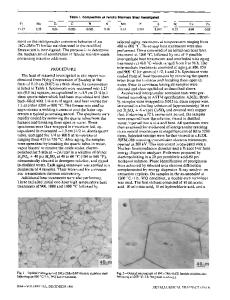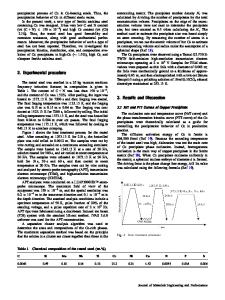Precipitation reactions during the heat treatment of ferritic steels
- PDF / 4,810,586 Bytes
- 9 Pages / 604 x 788 pts Page_size
- 5 Downloads / 398 Views
I.
INTRODUCTION
HIGH-chromium ferritic (martensitic) steels are widely used in the electrical power-generating industries and chemical and petroleum industries, l They are currently being considered as candidate alloys for first wall applications in fusion reactor systems. 2 Two such alloys are 9Cr-IMoV-Nb and 12Cr-IMo-V-W (commercially designated as Sandvik HT9). As part of the United States Department of Energy Fusion Energy Alloy Development Program, a study of the precipitation reactions in these alloys during heat treating was started, and the results are presented here. The objective of this investigation was to develop a better understanding of the precipitation behavior of these alloys as a function of heat treating conditions. Such an understanding should allow for a better interpretation of the results of radiation experiments currently in progress. The physical metallurgy of the 12Cr-1Mo-type alloys has been reviewed. 1~35 On the other hand, very little information has been reported for the 9Cr-lMo-type alloys, 5 especially for alloys that contain strong carbide-forming elements (e.g., vanadium or niobium). Although there have been extensive tempering studies on the 12Cr-lMo-type alloys, few detailed precipitation studies have been reported. What precipitation studies have been made on 9 and 12Cr alloys generally indicate that the primary precipitate that forms in both is M23C6; small amounts of MC, and in some c a s e s M z X , have also been reported.~.3-~~ These ferritic steels are commonly used in a "normalized and tempered" condition. This heat treatment involves a solutionizing treatment (austenitizing) that produces ausJ.M. VITEK and R.L. KLUEH are Research Staff Members, Oak Ridge National Laboratory, Oak Ridge, TN 37830. This paper is based on a presentation made at the "Peter G. Winchell Symposium on Tempering of Steel" held at the Louisville Meeting of The Metallurgical Society of AIME, October 12-13, 1981, under the sponsorship of the TMS-AIME Ferrous Metallurgy and Heat Treatment Committees. METALLURGICALTRANSACTIONS A
tenite and dissolves the carbides, followed by an air cool that transforms the austenite to martensite. The austenitization plus air cool is referred to as the normalization treatment. Typical normalized microstructures, which consist of a martensite lath network, are shown in Figure 1. In commercial practice, the normalized steels are tempered by heating between 650 to 780 ~ Although the optical microstructures after tempering appear similar to the normalized microstructure (Figure 2(a)), transmission electron microscopy shows a variation in structure, depending on the tempering conditions. For the high-temperature tempering treatment generally used (650 to 780 ~ the "tempered martensite" consists of a ferrite matrix with carbide precipitates (Figure 2(b)). In the present investigation, the carbide dissolution kinetics were studied by varying both the austenitizing time and temperature. In addition, the sensitivity of these alloys to cooling rate after austenitization was
Data Loading...











